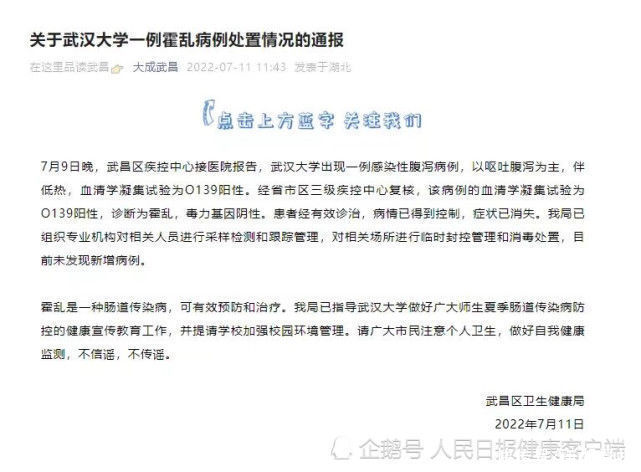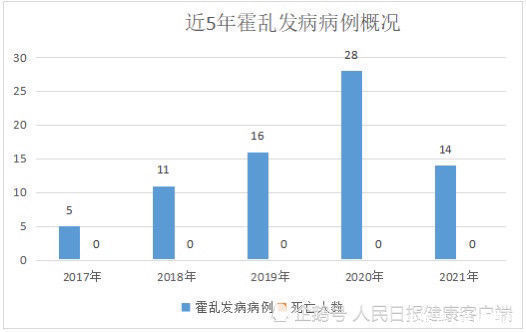“Cholera is a Class A infectious disease. Although it spreads quickly and is more harmful, with the improvement of living and hygiene conditions and living habits, the incidence rate is not high.” The director of the infectious disease department of a domestic top three hospital told the Health Times reporter You don’t have to panic, take precautions in your life, pay attention to dietary hygiene, and seek medical attention in time if you have diarrhea. If you have an infection, you can usually find it in the hospital.
On July 11, the Wuchang District Health Bureau of Wuhan City announced that on the evening of July 9, the Wuchang District Center for Disease Control and Prevention received a report from the hospital that a case of infectious diarrhea appeared in Wuhan University, which was later diagnosed as cholera.
The dormitory of the cholera case has been closed on the 10th, and the campus life is orderly.
According to the latest report of Wuhan University, the case is a graduate student of Wuhan University , lives in the Eighth House of the Faculty of Engineering, and has a past history of gastroenteritis. He developed fever, vomiting, and diarrhea at around 5:00 on July 8. He went to Wuhan University Hospital for treatment 5 hours later. He was transferred to Zhongnan Hospital of Wuhan University because of more than 3 times of diarrhea. He has been transferred to the People’s Hospital of Wuhan University for isolation. treat.

Picture of the WeChat public account of the Wuhan University Polytechnic Research Association in the dormitory of the Faculty of Engineering
It is reported that on the evening of July 9, Wuhan University received the After being notified by the center, it sealed and controlled the eight houses of the Faculty of Engineering and the laboratory where the case was located overnight, and tested the close contacts. Finally, it was determined that the case was in close contact with 3 people (2 roommates and 1 person who shared the meal), all of whom have been in close contact. Transfer to school isolation point for centralized isolation.
According to the feedback from the Wuhan CDC, the virulence gene is negative (Vibrio cholerae is less virulent), and after effective diagnosis and treatment, the student is in stable condition and the symptoms have disappeared. As of 19:36 on July 10, through the rapid inspection of 264 key groups and 259 points, no O1 and O139 Vibrio cholera were detected, and no new cases were found.

“At present, the daily office and life on campus are in an orderly manner, and everything is going on in an orderly manner.” Regarding the current situation in Wuhan University, a campus informed A source told the Health Times reporter that on the afternoon of July 10, both the official website of Wuhan University and the WeChat public account of the school’s student affairs department had posted “Warm Reminders on Strengthening the Prevention of Intestinal Infectious Diseases in Summer”. In addition, some colleges also urgently arranged for the staff to understand the students’ study and living conditions in school, and do a good job of explaining the work.
About the online anal swab test, the insider said that as of 15:00 on July 11, there has been no notification of large-scale anal swab testing, and Wuhan University has entered the summer vacation. There are not many students staying on campus, and the dormitory building where the confirmed patients live is far away from the dormitories of other departments.
Another person familiar with the matter told the Health Times reporter that the dormitory where the cholera case occurred this time was the Eighth House of the Faculty of Engineering, which was closed on the 10th. At present, all the people in the dormitory have been tested by anal swabs, and there is no news of new cases. Regarding the situation in the dormitory, the insider said that the students in the dormitory can move freely, but they cannot go out of the building, and three meals a day are uniformly delivered by the school.
Cholera epidemics are high from June to September, and prevention should be done in the “five dos and five nos”
Cholera is a digestive tract-borne disease. Similar infectious diseases, but the incidence is not very high. The reporter’s inquiry from the National Health and Medical Commission found that there are sporadic confirmed cases of cholera almost every year. From the data of the past five years, a total of 74 cases of cholera have been reported, and none of them died.

Zhao Yuan’s purpose drawing
Previously, according to the Chinese Center for Disease Control and Prevention (https://www.chinacdc.cn /jkzt/crb/jl/hl/zstd_10926/200606/t20060606_24454.html ) hyperchain, cholera can be transmitted by drinking or eating unsterilized water or food infected by Vibrio cholerae and contact with excrement of cholera patients and carriers Contaminated hands and objects and eating food contaminated with flies. Its epidemic time is March-November, of which June-September is the peak of the epidemic. The population is generally susceptible, especially those with achlorhydria. The incubation period for cholera is generally several hours to 5 days, usually 2-3 days. In most cases, cholera infection results in only mild diarrhea or no symptoms at all. The typical symptoms are severe painless watery diarrhea, severe diarrhea a dozen times a day. Cholera infection, if not treated promptly or properly, can lead to severe dehydration and death.
How should the public be prevented? The Chinese Center for Disease Control and Prevention pointed out that the main thing is to “keep a good mouth” and prevent diseases from entering through the mouth. Do five or five.
Five tips: Wash your hands before and after meals, cook seafood when you buy back, heat food between meals thoroughly, separate raw and cooked food, and seek medical attention if you have symptoms.
Five do not: Do not drink raw water, do not patronize unlicensed food, do not eat rotten food, do not overeating, do not touch unsterilized (cholera-contaminated) items .
“With the current level of medical care, cholera infection can generally be detected if you can seek medical treatment in time. After treatment, it can basically be well controlled within 1-2 days, so you don’t need to panic.” The expert express.
Source: People’s Daily Health Client
News Clues and Revelations 0731-85571188.